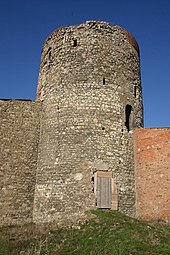Freckleben Castle
| Freckleben Castle | ||
|---|---|---|
|
Keep from 1200, courtyard side |
||
| Creation time : | 900 to 1000 | |
| Castle type : | Höhenburg, spur location | |
| Conservation status: | Preserved essential parts | |
| Standing position : | Nobles, counts, clericals | |
| Place: | Freckleben | |
| Geographical location | 51 ° 41 '50 " N , 11 ° 32' 47" E | |
|
|
||
The castle Freckleben is a Roman hilltop castle in Freckleben in Salzlandkreis , Saxony-Anhalt . Significant remains of what are probably Carolingian ramparts and well-preserved Romanesque buildings from around 1200 can be seen.
history
The origin of the first fortification in Freckleben cannot yet be precisely classified. A first documentary mention of the place 762 in the Fulda foundation book as Frekenlevo confirms the old age of the place. It is possible that the extensive ramparts that have been preserved to this day can be traced back to this time. The extension of the ramparts covers an area several times the size of the later medieval castle. The approximately oval castle area has in its largest dimensions an extension of 300 x 600 meters. The terrain in the spur is protected on three sides by steep slopes. The south side was protected by a system of three successive walls with a double moat in between . Another outer wall is about 120 meters south of it on the natural slope of the site. The appearance of the ramparts makes a Carolingian castle appear possible.
On October 22nd, 973, Emperor Otto II confirmed an exchange of goods between Archbishop Adalbert von Magdeburg and Abbot Werner von Fulda , in which Adalbert received Freckleben. Adalbert died there in 981. One can probably assume that there was a representative aristocratic residence at that time.
In the 12th century were the Margrave of the Nordmark from the Counts of Stade owner of the castle. The round tower of the lower castle ( Bergfried 1) dates from the time of their reign . Stylistically, it can be classified in the first half of the 12th century, which is indicated by its massive building dimensions, but also by the simple Romanesque building elements. It is noteworthy that the tower was reinforced by an outer jacket in a second construction phase. (Wall thickness: three meters, inner diameter: four meters, jacket wall: 1.3 meters, preserved height: 16 meters) In addition to the tower, parts of the curtain wall and the basement of a residential building in the southeast of the castle from the time of the margraves have been preserved.
The last representative of the von Stade family, Count Udo von Freckleben , was killed on March 15, 1130 by the men of Albrecht the Bear in Aschersleben . The later emperor Lothar III. The rule moved in as an ownerless fiefdom and awarded it as an imperial fiefdom . In 1135 an Eckerich von Frakenleve and an Otto von Frakenleve were mentioned in a document. As part of an exchange of goods, Archbishop Wichmann von Seeburg acquired Freckleben in 1166 from Emperor Friedrich I. Located on an important road from Halle to Aschersleben and Halberstadt , it was an important link between the archbishopric estates.
The keep 3 was built around 1200. The tower, which is rectangular in the lower four floors, merges into an octagonal floor plan on the fourth floor. The third and fourth floors are built for residential purposes with a fireplace and toilet bay. The outward-facing front has Romanesque twin windows on these floors. The other buildings of the upper castle were also built during this time. The courtyard of the upper castle must have been built on on all sides, as the high access to the tower has a stop for a drawbridge . That assumes a building opposite. To the north of keep 1, a building was built that is characterized by thicker walls and was probably a residential building.
The castle was administered by burgraves until 1296 . When the last burgrave, Walter V von Arnstein, entered the Teutonic Order that year , the office was not filled again. The rule was given to various noble families as fiefs. The rule was divided several times. In 1479, Prince Waldemar and Georg von Anhalt bought the rulership from the Dorstädt and Strobart families and took it as a fief from the Archdiocese of Magdeburg . Freckleben had been a domain since the 16th century.
During the division of Anhalt in the 17th century, Freckleben came to the Dessau line. At the time of the domain economy in the 19th and 20th centuries, the farm buildings were rebuilt and changed many times. In 1896 the domain fell to the state. Around 1900 a large round tower (keep 2) in the lower castle was demolished. In 1945 the domain was divided up and several new farms were built in the castle buildings.
sightseeing
The outdoor areas are freely accessible and the keep can be climbed using ladders. The top two floors are equipped with rotary spindle ladders, which are unique in Germany.
literature
- Karl Heinz Kukla: Freckleben Castle and its building history . In: Scientific articles from the Martin Luther University Halle-Wittenberg, Social and Linguistic Sciences VIII / 3 . Pp. 461-478.



